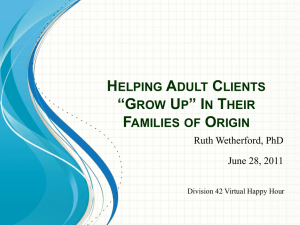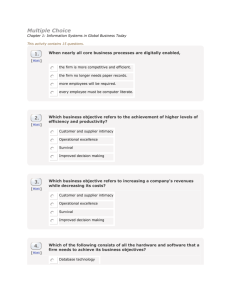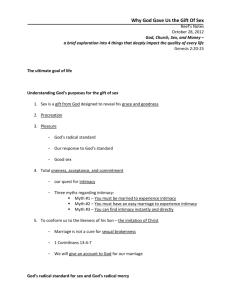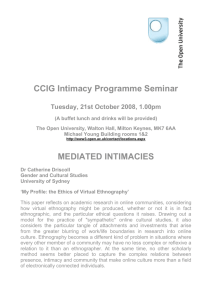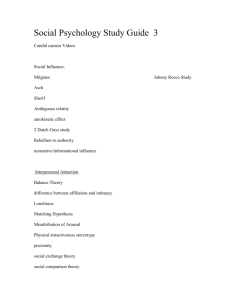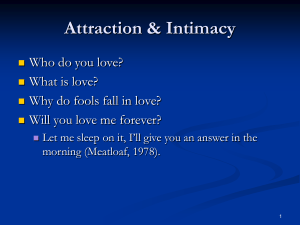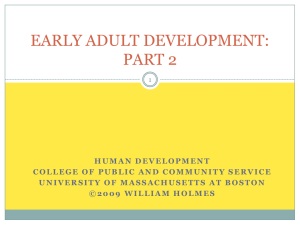Ch.9 Dynamics of Relationships
advertisement
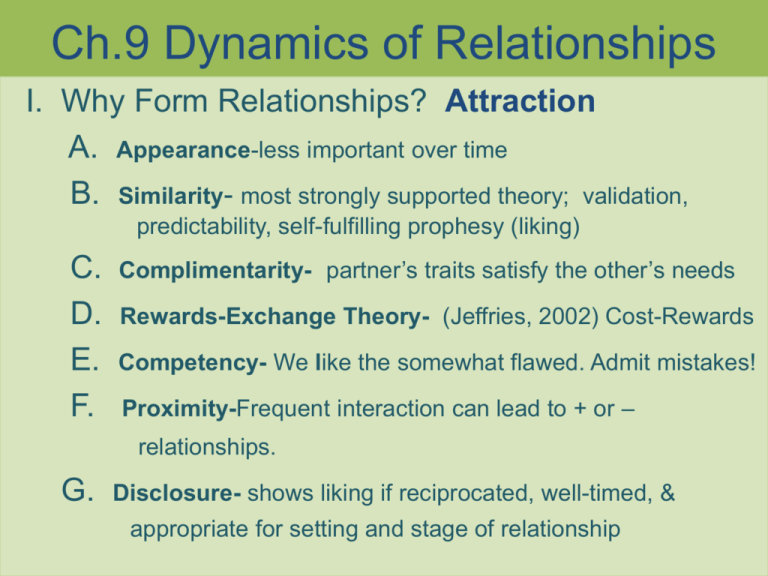
Ch.9 Dynamics of Relationships I. Why Form Relationships? Attraction A. Appearance-less important over time B. Similarity- most strongly supported theory; validation, predictability, self-fulfilling prophesy (liking) C. D. E. F. Complimentarity- partner’s traits satisfy the other’s needs Rewards-Exchange Theory- (Jeffries, 2002) Cost-Rewards Competency- We like the somewhat flawed. Admit mistakes! Proximity-Frequent interaction can lead to + or – relationships. G. Disclosure- shows liking if reciprocated, well-timed, & appropriate for setting and stage of relationship Intimacy • Intimacy may be the single most important source of life satisfaction and emotional well-being, across …ages and cultures. (Peterson, 2006) • Dimensions of Intimacy (sharing) – Emotional (sharing important information & feelings) – Physical (sharing physical closeness is strongest in childhood; opportunities can lessen with age; enduring challenges together can create a bond for life) – Intellectual (sharing important ideas) – Activity Sharing (sharing struggles against obstacles or rooming together can create strong bonds; play = a shared activity) • Amount & type of intimacy vary from one relationship to another. • NOT all relationships=intimate; 1 to 4 dimensions; not all at high level • Living w/o any isn’t a good idea; can result in problems creating/ maintaining relationships Gender & Intimacy II.Influences on Amount and How Communicated A. Gender- Male & Female Intimacy Styles 1. Past=believed women more concerned w/ & better at developing & maintaining intimate relationships a. Now= differences aren’t dramatic 2. Was based on self-disclosure, but there are other ways to develop close relationships 3. Men & women express it differently a. Women- disclose more= caring= talking b. Men- shared activities = caring =doing with & doing for i. Women=sex expresses existing intimacy/ closeness ii. Men=sex creates intimacy -a way to build closeness c. These are generalizations; stereotypes are changing! i. U.S cultural shift =fathers becoming more affectionate with sons than previous generations, but some still with shared activities. ii. Shared activities still express some affection (biological sex & cultural norms ) II. B. Culture and Intimacy Ideas about intimacy vary culture to culture. Greatest differences between Asian & European cultures involve rules for dealing w/ intimacy. (Argyle & Henderson, ‘85) – Including showing emotions, expressing public affection, engaging in sexual activity, & respecting privacy. Large East/West differences are disappearing. (Hatfield & Rapson, 2006) Remember norms for appropriate intimacy in other cultures. Be aware & sensitive to honoring their standards, not yours. Influences on Influences on Intimacy, cont. Formed for Commitment II. Communication & Relationship Dynamics • Models attempt to describe & explain how communication in a relationship changes over time and how it reflects what’s happening in a relationship. • Knapp’s model breaks it into 10 stages, • While Baxter and others describe it as always present dialectical tensions we struggle with internally & externally. II. Communication and Relational Dynamics A. Knapp’s Developmental Model of Relational Maintenance (10 stages) 5. Bonding 4. Integrating 3. Intensifying 2. Experimenting 1. Initiating 6. Differentiating 7. Circumscribing 8. Stagnating 9. Avoiding 10. Terminating *Start with #1, go up <Coming Together>, across, then go down <Coming Apart>. (Limits of Developmental Models) • They don’t describe everyday relationships not progressing predictably, stage to stage. • The following Relational Dialectics attempt to explore that more than one stage can occur at a time. • We can have opposing, incompatible desires, within the relationship (internally) & when facing others whose desires conflict w/ ours.(externally). • These tensions are never completely resolved, but we should work through these dialectical tensions with relational maintenance. Relationship Dynamics cont. B. Dialectical Tensions 1. Integration vs. Separation: *Internal= Connection vs. Autonomy; External= inclusion vs. seclusion (desire to connect w/ outside world vs. desire to be free of interference from others) 2. Stability vs. Change: Internal= predictability vs novelty; Externally= conventionality vs. uniqueness (meeting others’ expectations & your own) 3. Expression vs. Privacy: *Internal= openness vs. Closedness (complete honesty not always best); External= revelation & concealment (how much to share? ) *= most important in romantic relationships (Baxter & Ebert, 1999) Managing Dialectical Tensions D. Strategies for Managing Dialectical Tensions 1. Denial : it may be too diff. to change so rather have predictability 2. Disorientation: feel overwhelmed/unable to confront problems, so may do something drastic( fight, freeze, or leave relationship) 3. Alternation: Choose between each end of spectrum (when to spend lots of time together and when to be independent) 4. Segmentation: Compartmentalize areas of the relationship. Ie. <open-closed=decide okay to share some things, but others will be off limits, like past lovers, etc.> 5. Balance: Compromise=each loses something. Not ideal but workable 6. Integration: Adapt & blend. Accept opposing forces w/o trying to diminish them. (Adoptive famlies , couples “predictably novel”) 7. Recalibration: Redefine (reframe) challenges so not problems (secrets create mystery) 8. Reaffirmation: Accept or embrace challenges, just part of relationship. “Life is a roller coaster” idea, and dialectical tensions = part of the ride. (p.301) III. Maintaining Relationships w/ Commun. A. Communicating about Relationships 1. Content & Relational Messages a. Content dimension-the words, the subject discussed (verbal) b. Relational dimension-statements about how we feel toward each other(verbal & nonverbal) ▪ Deals with social needs of affinity, respect, intimacy, & control but may not be noticed until doesn’t match beliefs about social need(s)>. ▪ How speaker feels abt. message receiver III. Maintaining Relationships cont. A. Communicating About Relationships, cont. 2. Expressing Relational Messages a. Usually nonverbal (ambiguous) b. Verify accuracy before responding c. Metacommunication: messages referring to other messages (1.) Can keep relationship on track (2.) Sometimes threatens receiver & provokes conflict III. B. Maintenance Strategies <5 tactics to persuade others to think or act as we wish (Stafford & Canary, 1991)> 1. Positivity: staying pleasant by being polite, cheerful, & upbeat & avoiding criticism. 2. Openness: Talking directly about the nature of the relationship & disclosing personal needs & concerns 3. Assurances: Letting other persons know he or she matters 4. Sharing tasks: Helping each other take care of chores & obligations 5. Social Networks: Relying on family & friends for support & relief to help partners understand & appreciate each other, & giving them other sources of companionship that take some load off the relationship C. Repairing Damage 1. Depends on type of problem - From outside: work, finances, etc. - Differences/disagreements with each other within the relationship - Transgressions: A partner violates the terms of the agreement, whether explicit or implicit, letting the other down. Repairing Damage, cont. 2. Depends on Type of Transgression a. Minor vs. significant: In large, regular doses, ordinary things can become transgressions & damage relationships (jealously). b. Social vs. relational: Intentionally violating social rules (saving face) vs. parties constructed norms (rules) for relationship (calling when late) feels like transgression, but others may not agree. c. Deliberate vs. unintentional: Not meaning to reveal something vs. lashing out , trying to hurt a partner. d. Once vs. incremental: Single episodes vs. those happening over time, becoming serious violations III. Repairing Relationships, cont. A. 3 Repair strategies 1. Talk about it (Dindia & Baxter, 1987) ▪Some harder to discuss than others ▪ Sexual infidelity & breaking up = least forgivable (Bachman & Guerrero, 2006) 2. Offer an apology w/ 3 elements: – Clear statement you’re wrong: “ I acted selfishly.” – Sincerity: “I am really sorry I let you down. You didn’t deserve it.” – Some type of compensation: “I’ll never do it again.” III. Repairing Relationships, cont. (A. 2.) Apologies • Verbal & Nonverbal behaviors must match or it isn’t perceived as sincere. • Forgiveness may include behavior change demonstrated over time, not just saying it. (Merolla, 2008) • Worth the effort? YES! Study proves more remorse over ones not offered. (Exline et al, 2007) III. Repairing Damaged Rela., cont. Dynamics in Relationships cont. IV. Compliance-Gaining in Relationships A. Compliance Strategies 1. Defined: Tactics we use to persuade others to think or act as we wish 2. Competent communicators will consider a number of ways to get a desired response BEFORE choosing the best approach (what we hope is the best one). 3. Compliance-gaining develops early in childhood. a. Scripts develop from trail and error and get them what they want. (“please & “thank you”) b. When older, kids consider a variety of age-appropriate approaches, specific to persons B. Types if Compliance Strategies 1. Direct Requests - simple, honest & effective most of time, esp. w/ a reason for it given. 2. Indirect Appeals - Usually hints, used when uncomfortable w/ direct request can be sensible and ethical. (safety for battered wives) • End of Ch. 9 Relational Dynamics cont. IV. Types of compliance Strategies – cont. B. Types if Compliance Strategies 1. Direct Requests - simple, honest & effective most of time, esp. w/ a reason for it given. 2. Indirect Appeals - Usually hints, used when uncomfortable w/ direct request can be sensible and ethical. (batt. wives) 3. Reciprocity – an expectation (norm)that obligates us to return favors extended to us even if we don’t like the person a. Can be “win-win” for both, or b. Manipulative to trick others into doing things they wouldn’t do. (lending money) 4. Reward & Punishment - “If you do X, I’ll do Y.” 5. Face-Maintenance - get desired response/others reinforce presenting selves by stroking egos or making feel Choosing Best Strategy • Competent communicators have a wide variety of strategies & are skilled at choosing the best one for the circumstance. – What will give you the best chance of success? – How will it affect the relationship in the long-term? – Does it conform to your values & your personal style? • Are you comfortable if used on you? Would you be comfortable revealing it to the one you are using it on? • More comfortable being direct or using face-saving benefits & other rewards? Sincerity matters in successful use of compliance strategies. Don’t rule out a strategy b/c not used to using it. It takes time to practice.
